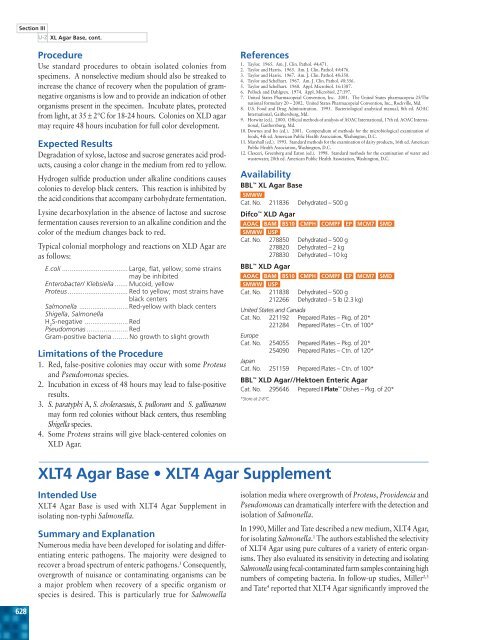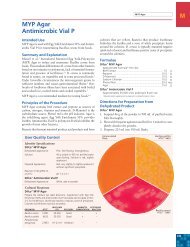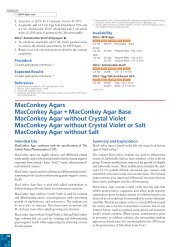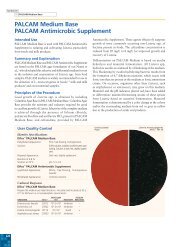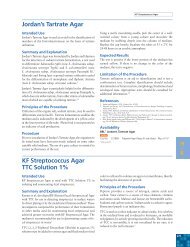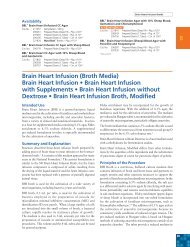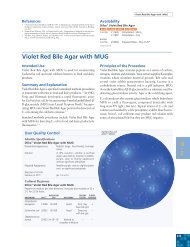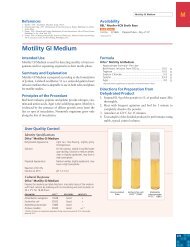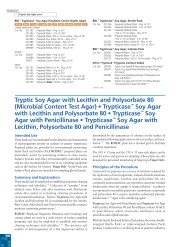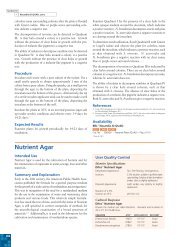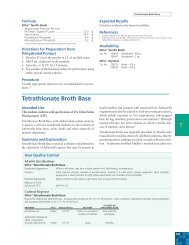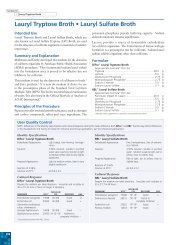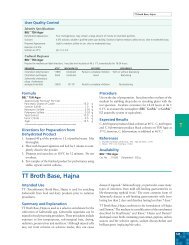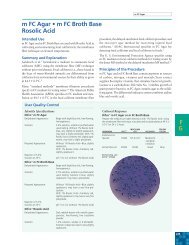XLT4 Agar Base ⢠XLT4 Agar Supplement - BVA Scientific
XLT4 Agar Base ⢠XLT4 Agar Supplement - BVA Scientific
XLT4 Agar Base ⢠XLT4 Agar Supplement - BVA Scientific
You also want an ePaper? Increase the reach of your titles
YUMPU automatically turns print PDFs into web optimized ePapers that Google loves.
Section IIIU-Z XL <strong>Agar</strong> <strong>Base</strong>, cont.ProcedureUse standard procedures to obtain isolated colonies fromspecimens. A nonselective medium should also be streaked toincrease the chance of recovery when the population of gramnegativeorganisms is low and to provide an indication of otherorganisms present in the specimen. Incubate plates, protectedfrom light, at 35 ± 2°C for 18-24 hours. Colonies on XLD agarmay require 48 hours incubation for full color development.Expected ResultsDegradation of xylose, lactose and sucrose generates acid products,causing a color change in the medium from red to yellow.Hydrogen sulfide production under alkaline conditions causescolonies to develop black centers. This reaction is inhibited bythe acid conditions that accompany carbohydrate fermentation.Lysine decarboxylation in the absence of lactose and sucrosefermentation causes reversion to an alkaline condition and thecolor of the medium changes back to red.Typical colonial morphology and reactions on XLD <strong>Agar</strong> areas follows:E.coli ................................... Large, flat, yellow; some strainsmay be inhibitedEnterobacter/ Klebsiella ....... Mucoid, yellowProteus ................................ Red to yellow; most strains haveblack centersSalmonella .......................... Red-yellow with black centersShigella, SalmonellaH 2S-negative ....................... RedPseudomonas ...................... RedGram-positive bacteria ........ No growth to slight growthLimitations of the Procedure1. Red, false-positive colonies may occur with some Proteusand Pseudomonas species.2. Incubation in excess of 48 hours may lead to false-positiveresults.3. S. paratyphi A, S. choleraesuis, S. pullorum and S. gallinarummay form red colonies without black centers, thus resemblingShigella species.4. Some Proteus strains will give black-centered colonies onXLD <strong>Agar</strong>.References1. Taylor. 1965. Am. J. Clin. Pathol. 44:471.2. Taylor and Harris. 1965. Am. J. Clin. Pathol. 44:476.3. Taylor and Harris. 1967. Am. J. Clin. Pathol. 48:350.4. Taylor and Schelhart. 1967. Am. J. Clin. Pathol. 48:356.5. Taylor and Schelhart. 1968. Appl. Microbiol. 16:1387.6. Pollock and Dahlgren. 1974. Appl. Microbiol. 27:197.7. United States Pharmacopeial Convention, Inc. 2001. The United States pharmacopeia 25/Thenational formulary 20 – 2002. United States Pharmacopeial Convention, Inc., Rockville, Md.8. U.S. Food and Drug Adminsitration. 1995. Bacteriological analytical manual, 8th ed. AOACInternational, Gaithersburg, Md.9. Horwitz (ed.). 2000. Official methods of analysis of AOAC International, 17th ed. AOAC International,Gaithersburg, Md.10. Downes and Ito (ed.). 2001. Compendium of methods for the microbiological examination offoods, 4th ed. American Public Health Association, Washington, D.C.11. Marshall (ed.). 1993. Standard methods for the examination of dairy products, 16th ed. AmericanPublic Health Association, Washington, D.C.12. Clesceri, Greenberg and Eaton (ed.). 1998. Standard methods for the examination of water andwastewater, 20th ed. American Public Health Association, Washington, D.C.AvailabilityBBL XL <strong>Agar</strong> <strong>Base</strong>SMWWCat. No. 211836 Dehydrated – 500 gDifco XLD <strong>Agar</strong>AOAC BAM BS10 CMPH COMPF EP MCM7 SMDSMWW USPCat. No. 278850 Dehydrated – 500 g278820 Dehydrated – 2 kg278830 Dehydrated – 10 kgBBL XLD <strong>Agar</strong>AOAC BAM BS10 CMPH COMPF EP MCM7 SMDSMWW USPCat. No. 211838 Dehydrated – 500 g212266 Dehydrated – 5 lb (2.3 kg)United States and CanadaCat. No. 221192 Prepared Plates – Pkg. of 20*221284 Prepared Plates – Ctn. of 100*EuropeCat. No. 254055 Prepared Plates – Pkg. of 20*254090 Prepared Plates – Ctn. of 120*JapanCat. No. 251159 Prepared Plates – Ctn. of 100*BBL XLD <strong>Agar</strong>//Hektoen Enteric <strong>Agar</strong>Cat. No. 295646 Prepared I Plate Dishes – Pkg. of 20**Store at 2-8°C.<strong>XLT4</strong> <strong>Agar</strong> <strong>Base</strong> • <strong>XLT4</strong> <strong>Agar</strong> <strong>Supplement</strong>Intended Use<strong>XLT4</strong> <strong>Agar</strong> <strong>Base</strong> is used with <strong>XLT4</strong> <strong>Agar</strong> <strong>Supplement</strong> inisolating non-typhi Salmonella.Summary and ExplanationNumerous media have been developed for isolating and differentiatingenteric pathogens. The majority were designed torecover a broad spectrum of enteric pathogens. 1 Consequently,overgrowth of nuisance or contaminating organisms can bea major problem when recovery of a specific organism orspecies is desired. This is particularly true for Salmonellaisolation media where overgrowth of Proteus, Providencia andPseudomonas can dramatically interfere with the detection andisolation of Salmonella.In 1990, Miller and Tate described a new medium, <strong>XLT4</strong> <strong>Agar</strong>,for isolating Salmonella. 1 The authors established the selectivityof <strong>XLT4</strong> <strong>Agar</strong> using pure cultures of a variety of enteric organisms.They also evaluated its sensitivity in detecting and isolatingSalmonella using fecal-contaminated farm samples containing highnumbers of competing bacteria. In follow-up studies, Miller 2,3and Tate 4 reported that <strong>XLT4</strong> <strong>Agar</strong> significantly improved the628
<strong>XLT4</strong> <strong>Agar</strong> <strong>Base</strong>, cont.User Quality ControlIdentity SpecificationsDifco <strong>XLT4</strong> <strong>Agar</strong> <strong>Base</strong>Dehydrated Appearance:Solution:Pink, free flowing, homogeneous.5.9% solution, soluble upon boiling inpurified water containing 4.6 mL/L of<strong>XLT4</strong> <strong>Agar</strong> <strong>Supplement</strong>. Solution is red,slightly opalescent.Prepared Appearance: Reddish-orange, slightly opalescent.Reaction of FinalMedium at 25°C: pH 7.4 ± 0.2Difco <strong>XLT4</strong> <strong>Agar</strong> <strong>Supplement</strong>Appearance:Colorless to slightly yellow, clear, slightlyviscous solution.Salmonella typhimuriumATCC 14028<strong>XLT4</strong> <strong>Agar</strong> <strong>Base</strong> with <strong>XLT4</strong> <strong>Supplement</strong>Cultural ResponseDifco <strong>XLT4</strong> <strong>Agar</strong> <strong>Base</strong> with <strong>XLT4</strong> <strong>Agar</strong> <strong>Supplement</strong>Prepare the medium per label directions. Inoculate and incubate at 35 ±2°C for 18-48 hours.INOCULUMCOLONYORGANISM ATCC CFU RECOVERY COLOREnterococcus faecalis 29212 10 3 Marked inhibition –Escherichia coli 25922 10 3 Partial inhibition YellowProteus mirabilis 25933 10 3 Inhibition –Salmonella choleraesuissubsp. choleraesuisserotype Typhimurium 14028 10 2 -10 3 Good Yellow to redwith black centersStaphylococcus aureus 25923 10 3 Inhibition –recovery of non-typhi Salmonella from chicken and farmenvironmental drag-swab samples.Principles of the Procedure<strong>XLT4</strong> <strong>Agar</strong> <strong>Base</strong> contains peptone as a source of complexnitrogen compounds. Yeast extract is added as a source ofvitamins and other cofactors. Differentiation of Salmonellafrom other organisms that also grow on this medium is basedon fermentation of xylose, lactose and sucrose, decarboxylationof lysine and the production of hydrogen sulfide. Hydrogensulfide production is detected by the addition of ferric ions.Sodium thiosulfate is added as a source of inorganic sulfur.Sodium chloride maintains the osmotic balance of the medium.<strong>Agar</strong> is the solidifying agent. Phenol red is added as an indicatorof pH changes resulting from fermentation and decarboxylationreactions. <strong>XLT4</strong> <strong>Agar</strong> <strong>Supplement</strong> is added to inhibit growthof non-Salmonella organisms.FormulaeDifco <strong>XLT4</strong> <strong>Agar</strong> <strong>Base</strong>Approximate Formula* Per LiterProteose Peptone No. 3 ............................................. 1.6 gYeast Extract .............................................................. 3.0 gL-Lysine ...................................................................... 5.0 gXylose ........................................................................ 3.75 gLactose ....................................................................... 7.5 gSaccharose ................................................................. 7.5 gFerric Ammonium Citrate ........................................... 0.8 gSodium Thiosulfate .................................................... 6.8 gSodium Chloride ........................................................ 5.0 g<strong>Agar</strong> ......................................................................... 18.0 gPhenol Red ................................................................. 0.08 gDifco <strong>XLT4</strong> <strong>Agar</strong> <strong>Supplement</strong>A 27% solution (approximate) of the surfactant Tergitol ** 4(7-ethyl-2-methyl-4-undecanol hydrogen sulfate, sodium salt).*Adjusted and/or supplemented as required to meet performance criteria.**Tergitol is a trademark of Union Carbide Chemicals & Plastics Technology Corporation.Directions for Preparation fromDehydrated Product1. Suspend 59 g of the powder in 1 L of purified water.2. Add 4.6 mL <strong>XLT4</strong> <strong>Agar</strong> <strong>Supplement</strong>. Mix thoroughly.3. Heat with frequent agitation and boil for 1 minute to completelydissolve the powder. Avoid overheating. DO NOTAUTOCLAVE.4. Test samples of the finished product for performance usingstable, typical control cultures.Procedure1. Inoculate a suitable Salmonella enrichment broth (such asTetrithionate Broth) and incubate at 35°C for 18-24 hours.2. Following enrichment, subculture onto <strong>XLT4</strong> <strong>Agar</strong>. Streakfor isolation.3. Incubate plates aerobically at 35 ± 2°C. Examine for growthafter 18-24 and 48 hours incubation.Expected ResultsTypical Salmonella colonies (H 2 S-positive) appear black orblack-centered with a yellow periphery after 18-24 hours ofincubation. Upon continued incubation, the colonies becomeentirely black or pink to red with black centers.U -Z629
Section IIIU-Z <strong>XLT4</strong> <strong>Agar</strong> <strong>Base</strong>, cont.Colonies of H 2 S-negative Salmonella strains appear pinkishyellow.Most Citrobacter colonies that grow on this medium are yellowwithout evidence of blackening. Growth of Enterobacteraerogenes and Escherichia coli is markedly inhibited; coloniesthat do grow appear yellow without evidence of blackening.Growth of Proteus, Pseudomonas, Providencia, Alteromonasputrefaciens, Yersinia enterocolitica and Acinetobactercalcoaceticus is markedly to completely inhibited on <strong>XLT4</strong><strong>Agar</strong>. Shigella species are partially inhibited and colonies appearred.Limitations of the Procedure1. <strong>XLT4</strong> <strong>Agar</strong> is intended for detecting and isolating Salmonellabased on selectivity and colonial characteristics. PresumedSalmonella colonies must be confirmed by biochemical and/or immunological methods. Consult appropriate referencesfor further information. 5-72. Non-Salmonella strains that are not completely inhibitedon this medium may be encountered and must be differentiatedfrom Salmonella. Consult appropriate references. 5-73. Freshly inoculated plates and plates held over several daysmay develop multicolored, metallic looking crystals/fleckson the surface. These crystals/flecks do not interfere withthe performance of the medium.References1. Miller and Tate. 1990. The Maryland Poultryman April:2.2. Miller, Tate, Mallinson and Schemer. 1991. Poultry Science 70:2429.3. Miller, Tate, Mallinson and Schemer. 1992. Poultry Science 71:398.4. Tate, Miller and Mallinson. 1992. J. Food Prot. 55:964.5. U.S. Department of Agriculture. 1998. Microbiology laboratory guidebook, 3rd ed., Food Safety andInspection Service, USDA, Washington, D.C.6. Murray, Baron, Pfaller, Tenover and Yolken (ed.). 1999. Manual of clinical microbiology, 7th ed.American Society for Microbiology, Washington, D.C.7. Downes and Ito (ed.) 2001. Compendium of methods for the microbiological examination of foods,4th ed. American Public Health Association, Washington, D.C.AvailabilityDifco <strong>XLT4</strong> <strong>Agar</strong> <strong>Base</strong>USDACat. No. 223420 Dehydrated – 500 gDifco <strong>XLT4</strong> <strong>Agar</strong> <strong>Supplement</strong>USDACat. No. 235310 Bottle – l00 mLXanthine <strong>Agar</strong>(See Nocardia Differentiation Media)YM <strong>Agar</strong> • YM BrothIntended UseYM <strong>Agar</strong> and YM Broth are used for cultivating yeasts, moldsand other aciduric microorganisms.Summary and ExplanationYM <strong>Agar</strong> and YM Broth (Yeast Mold <strong>Agar</strong> and Broth) areprepared according to the formulae published by Wickerham. 1-3Wickerham suggested that YM Broth acidified to pH 3.0-4.0be used as an enrichment medium for yeasts from populationsalso containing bacteria and molds.Media selectivity may be enhanced through acidification orthrough addition of selective agents. YM Broth may be acidifiedprior to sterilization. YM <strong>Agar</strong> should be sterilized withoutpH adjustment and sterile acid added to the sterile moltenmedium cooled to 45-50°C. Acidified YM <strong>Agar</strong> should not beheated. Antibiotics may be aseptically added to the sterile media.Other fungistatic materials, such as sodium propionateand diphenyl may be added to YM <strong>Agar</strong> to eliminate moldsand permit the enumeration of yeasts in mixed populations.Principles of the ProcedureYeast extract is a source of trace elements, vitamins and aminoacids. Malt extract is a source of carbon, protein and nutrients.Peptone is an additional source of carbon and providesnitrogen and amino acids. Dextrose provides carbon. <strong>Agar</strong> isthe solidifying agent.FormulaeDifco YM <strong>Agar</strong>Approximate Formula* Per LiterYeast Extract .............................................................. 3.0Malt Extract................................................................ 3.0Peptone ..................................................................... 5.0Dextrose ................................................................... 10.0<strong>Agar</strong> ......................................................................... 20.0Difco YM BrothConsists of the same ingredients without the agar.*Adjusted and/or supplemented as required to meet performance criteria.Directions for Preparation fromDehydrated Product1. Suspend the powder in 1 L of purified water:Difco YM <strong>Agar</strong> – 41 g;Difco YM Broth – 21 g.Mix thoroughly.2. Heat the agar medium with frequent agitation and boil for1 minute to completely dissolve the powder.3. Autoclave the agar and broth media at 121°C for 15 minutes.ggggg630


